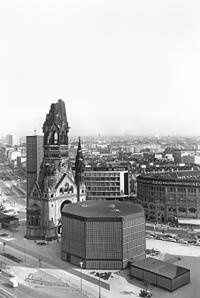Egon Eiermann
dal 28/1/2005 al 16/5/2005
Segnalato da
28/1/2005
Egon Eiermann
Bauhaus-Archiv, Berlin
On the occasion of Egon Eiermann's 100th birthday, the Bauhaus Archive is showing the first major retrospective of his fascinating and diverse oeuvre. With the German Pavilion for the 1958 World Exposition in Brussels, Eiermann established an international reputation as an architect of Modernism, and as a German architect representing a new, democratic nation.

The Continuity of Modernism
The first place that many people go to see when they visit Berlin is the
Kaiser Wilhelm Memorial Church. Because of its parallel significance as an
admonishing war memorial and as a symbol of a new beginning, it has become a
landmark of the City of Berlin. The architect responsible for this
masterpiece was Egon Eiermann.
On the occasion of Egon Eiermann's 100th birthday, the Bauhaus Archive is
showing the first major retrospective of his fascinating and diverse oeuvre.
With the German Pavilion for the 1958 World Exposition in Brussels, Eiermann
established an international reputation as an architect of Modernism, and as
a German architect representing a new, democratic nation. Important building
projects followed: the German Chancery in Washington, D.C. and the
Parliamentary Office Tower in Bonn ('Langer Eugen') for the federal
government, the headquarters of the Neckermann mail order company in
Frankfurt/Main, and administrative complexes for IBM in Stuttgart and for
Olivetti in Frankfurt/Main.
Egon Eiermann was already a known figure in architectural circles during the
1930s. After studying under Hans Poelzig, he specialised in building types
for which modern forms were deemed appropriate even by the National
Socialists. In this way, he was able to realise modern architectural
concepts for industrial buildings, display spaces and stores, as well as
private residences. Throughout the war period, Eiermann developed an
architectural idiom that allowed a seamless progression after 1945.
Soon after the war, in 1947, Eiermann was appointed Professor of
Architectural Planning and Design at the Technische Hochschule in Karlsruhe.
As an enthusiastic and committed teacher, he became an important mentor to
many students.
The continuity of Eiermann's architectural vocabulary is evident throughout
his entire oeuvre. It is already recognisable in his early work in the
precise, self-assured simplicity of floor plans and in the functional
clarity of structural volumes. His buildings have a light and
straightforward appearance, an almost cheerful transparency and openness.
This is also true of his interiors: tables, chairs, staircase railings,
coat-racks - the interior elements merge with the architecture in a unified
design concept. The success of his table frames and chairs has
simultaneously secured him a place in design history. Eiermann's interest in
design tasks extended even into the realm of funerary objects and
traditions.
The exhibition gives a comprehensive overview of Eiermann's complete works.
Sketches and drawings offer insights into his working methods; scale models
of buildings make it possible to form an impression of his architecture; a
computer simulation provides a visual reconstruction of the World Exposition
Pavilion in Brussels; letters and other writings document the activities of
his office.
The work of Egon Eiermann was of major significance for the continuity of
modern architecture in Germany. In contrast to the pioneers of 'New
Objectivity' (Neue Sachlichkeit), Eiermann remained in Germany after 1933.
As a young and still unknown architect, he specialised in building types for
which the National Socialists tolerated modern architectural forms: e.g.
factories, stores and private homes. After the war, Eiermann was able to
draw on this experience, and devoted himself to the reconstruction of
war-torn Germany as a skilled proponent of modern architecture. With
exceptional buildings, including the Kaiser Wilhelm Memorial Church in
Berlin (1956 - 1963) and the German Pavilion at the 1958 World Exposition in
Brussels, Eiermann made important contributions to domestic and
international architecture. Not only his buildings, but also his design
objects are distinguished by an emphasis on function and precise detailing.
The interdependence of material qualities, structural logic and
architectural form is consistently evident in his work.
On the occasion of Egon Eiermann's 100th birthday, this first comprehensive
retrospective of his oeuvre is being presented by the Südwestdeutsches
Archiv für Architektur und Ingenieurbau (saai) at the University of
Karlsruhe (TH) in collaboration with the Städtische Galerie Karlsruhe and
the Bauhaus Archive Berlin.
Catalogue, 224 pages., 308 illustrations., EUR39,80 (English) EUR24.-
(German)
Bauhaus-Archiv / Museum für Gestaltung
Klingelhöferstraße 14
D - 10785 Berlin
Hours: daily 10:00 a.m. - 5:00 p.m., closed Tuesdays
Information: Publicity Office: Bärbel Mees
Telephone:0049 (0) 30 - 25 40 02 43



